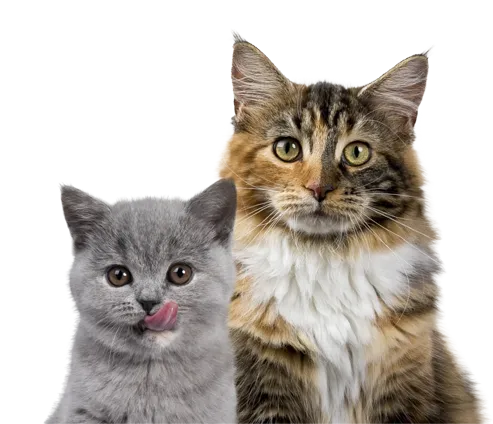
Your cat, like all cats, spends a large part of each and every day grooming themselves. And who doesn’t want to look their best as a cat? Ensuring their coat is in prime condition is a top priority for your feline friend.
But when does your cat’s grooming tip over from what’s considered a ‘normal’ amount to ‘excessive’?
We will answer this question, along with tips on what might be causing the issue and how to help your cat, in the article below.
What is classed as ‘excessive’ grooming?
‘Over-grooming’ is the term used to describe when a cat grooms more often than what’s considered normal. You might notice them grooming themselves more regularly, although often cats will groom themselves more often and more aggressively when no one is nearby, and in the most severe cases you may notice patches of sparse fur or skin showing where they have over-groomed their coat and pulled out clumps of fur.
If there is bare skin showing, you may find your cat has scratched or bitten the skin, and it can be hard to stop them returning to the affected area or wound. In this case, we recommend taking your cat to the vet for advice.
What causes over-grooming in cats?
One of the main factors behind over-grooming is stress. This stress and anxiousness could be caused by a major change to their routine, such as moving home, introducing a new member of family — whether it’s a pet or baby — another cat asserting dominance over them or a change to their feeding routine.
As a way of dealing with this stress, many cats groom to calm themselves down when they’re feeling anxious. This calming mechanism can become compulsive over time, so that your cat begins to groom even when they’re not stressed, leading to fur-loss.
Often, this fur-loss is evident in a small patch of stubbly skin, usually on a leg or on the belly. The skin may look red and inflamed, and sometimes there may be sores visible as a result of the over-grooming.
Other causes of excessive grooming in cats can include:
- Allergies
One allergy that can lead to over-grooming is as sensitivity to flea saliva, causing irritation to the skin. Other allergies that could lead to problems could include pollen, dust mites or even their food (see Cat Food Advisor’s Best Foods for Cats With Allergies).
- Feline hyperaesthesia syndrome aka rolling skin disease
This is a syndrome that affects the sensitivity of a cat’s skin, making it hyper-sensitive. You may notice that cats suffering from this condition become sensitive to human touch, their skin twitches and they might vocalize their pain if it’s severe. If this is the case, your vet will prescribe medication to help the condition.
- Parasites
One of the main reasons your cat might be preening themselves more excessively and aggressively is due to parasites living in their fur. Fleas are a common problem for cats, and might explain why your cat is itching and scratching more than usual. The good news is that this problem can be treated easily via ant-flea treatment available from your vet.
Other parasites can include mites or ticks. If you’re worried your cat may have a parasite infestation, take them to your veterinary surgeon who can diagnose and treat the issue. You can find out more about fleas and ticks in our article on the subject.
How to stop your cat over-grooming
The first thing to do is work out what’s causing your cat to groom excessively. If you believe it’s caused by stress, work out where the stress stems from. If you have just moved house or introduced a new pet or baby, it may be fairly obvious as these are major changes to your cat’s habitat and routine that could be causing your cat to feel unsettled.
It may not be immediately obvious what is causing your cat’s anxiety to spiral, though. If that’s the case, try some general methods of calming your cat, such as playing with them more, or using a pheromone product to help alleviate their high stress levels. If your vet diagnoses a serious case of high-anxiety, they might prescribe anti-anxiety medication for your cat.
If your vet or dermatologist has diagnosed an allergy, they will advise you on ways to treat it and help reduce your cat’s symptoms. If it’s a food allergy, there are plenty of cat foods available for cats with specific allergies, whether it’s grain or other ingredients.
We uphold the highest editorial standards when creating the authoritative content pet parents rely on and trust.
Every piece of clinical content on the Cat Food Advisor is reviewed by our certified Veterinary Advisory Board, which consists of licensed veterinarians and medically certified specialists.
Our reviews are completely independent; we are not paid by any pet food company to promote their products favorably. We do not accept money, gifts, samples or other incentives in exchange for special consideration. For more information see our Disclaimer & Disclosure page.









